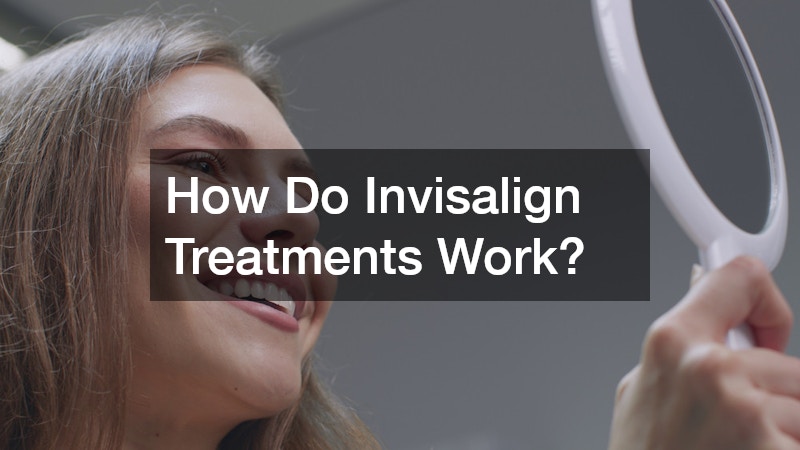Invisalign has transformed the way people achieve straighter, healthier smiles without the discomfort or appearance of traditional metal braces. This innovative treatment uses clear, removable aligners to gradually shift teeth into alignment. Understanding how Invisalign works helps patients make informed decisions about whether it’s the right orthodontic solution for them.
What is Invisalign?
Invisalign is an advanced orthodontic system that uses a series of custom-made, clear plastic aligners to gradually move teeth into the desired position. Each aligner is worn for about one to two weeks before being replaced with the next in the series, ensuring steady progress toward a straighter smile.
The aligners are virtually invisible, making them a preferred choice for those seeking a subtle orthodontic solution.
Benefits Over Traditional Braces
Unlike metal braces, Invisalign aligners are nearly invisible and can be removed for eating, brushing, and flossing. They cause less irritation to the gums and cheeks, require fewer office visits, and allow patients to maintain normal oral hygiene habits.
Components of Invisalign Aligners
Each Invisalign aligner is made from a patented, medical-grade thermoplastic material called SmartTrack. This material provides a precise, comfortable fit and applies consistent, gentle pressure to move teeth efficiently.
Average Cost of Invisalign
The cost of Invisalign depends on the complexity of the case, location, and duration of treatment. Many dental offices offer financing options or insurance coverage to make treatment more affordable.
How Does the Invisalign Process Work?
The journey begins with an in-depth consultation where your dentist or orthodontist evaluates your oral health and discusses treatment goals. Digital scans or impressions are taken to assess your teeth’s alignment and determine if Invisalign is the right fit for your needs.
Custom Treatment Plan
Using advanced 3D imaging and digital scanning technology, your dentist creates a personalized treatment plan that maps out every step of tooth movement. This simulation allows patients to preview their expected results before treatment even begins.
Production and Fitting of Aligners
Once the plan is finalized, a series of custom aligners is produced in a dental lab. During your fitting appointment, the first set of aligners is checked for comfort and accuracy, and instructions are provided on how to wear and care for them.
Wearing Your Aligners
Invisalign aligners must be worn for 20 to 22 hours per day, only being removed for meals and oral hygiene. Each set is typically worn for one to two weeks before switching to the next aligner in the series.
Adjustments and Progress Check-ins
Regular check-ins every six to eight weeks allow your dentist to monitor progress and ensure your teeth are moving as planned. These visits are usually brief and less frequent than with traditional braces.
Are There Any Limitations or Considerations?
While Invisalign is effective for many mild to moderate alignment issues, severe crowding or complex bite problems may still require traditional braces. Your dentist will recommend the best option based on your specific needs.
Age and Invisalign: Who Can Use Them?
Invisalign is suitable for teens and adults alike. Invisalign Teen is specifically designed for younger patients, offering features like wear indicators to ensure consistent use.
Challenges with Consistency
Because Invisalign aligners are removable, success depends on patient discipline. Inconsistent wear can delay results or reduce treatment effectiveness.
Maintenance and Care for Aligners
Aligners should be cleaned daily using a soft toothbrush or Invisalign cleaning crystals. Avoid using hot water, as it can warp the plastic. Proper hygiene prevents staining and keeps aligners clear.
Eating and Drinking with Aligners
Patients should remove aligners before eating or drinking anything other than water. This prevents staining, warping, or trapping food particles that could affect oral health.
What Are the Expected Results and Timeline?
The average Invisalign treatment lasts between 12 and 18 months, though minor corrections may take as little as six months. Treatment length depends on factors like tooth movement complexity and patient compliance.
Visible Changes: When to Expect Results
Many patients notice visible changes within the first few months of wearing aligners. The gradual progress motivates continued consistency and care throughout the process.
Comparing Results to Traditional Braces
When worn as directed, Invisalign can deliver results comparable to traditional braces. The main advantage lies in comfort, aesthetics, and convenience rather than clinical effectiveness alone.
Follow-Up Treatments and Retainers
After completing Invisalign treatment, patients must wear retainers to maintain results. Retainers prevent teeth from shifting back and ensure long-term stability.
Patient Testimonials and Experiences
Patients often describe Invisalign as comfortable, discreet, and life-changing. Many appreciate being able to smile confidently throughout treatment without metal brackets or wires.
Achieve a Confident Smile with Invisalign
Invisalign offers a modern, effective, and nearly invisible way to straighten teeth. By combining digital precision with patient convenience, it provides a customized orthodontic experience that fits seamlessly into daily life. Understanding how Invisalign works empowers individuals to take the next step toward achieving a healthier, more confident smile.

